Detailed Analysis and Review of Business Process Management Article
VerifiedAdded on 2021/06/17
|10
|2406
|24
Report
AI Summary
This report provides a detailed review of an article on Business Process Management (BPM) by Vom Brocke, Petry and Gonser (2016), focusing on how organizations identify, manage, and monitor business processes to improve efficiency. The review examines the core concepts of BPM, including run-time monitoring using LTL and LDL, and how it aligns with process improvement. The article discusses the development of BPM capabilities and the balance with individual business process enhancements, referencing frameworks by Chong (2014) and others. It highlights the importance of project management perspectives, decision models, and performance indicators in evaluating and implementing BPM roadmaps, emphasizing the integration of IT and management science. The conclusion underscores the importance of balancing BPM capabilities and individual business process improvements through a decision model that evaluates BPM roadmaps, supporting both process-level and BPM-level projects to enhance operational capabilities. The report also mentions the development of a prototype and demonstration example, and suggests areas for future research.
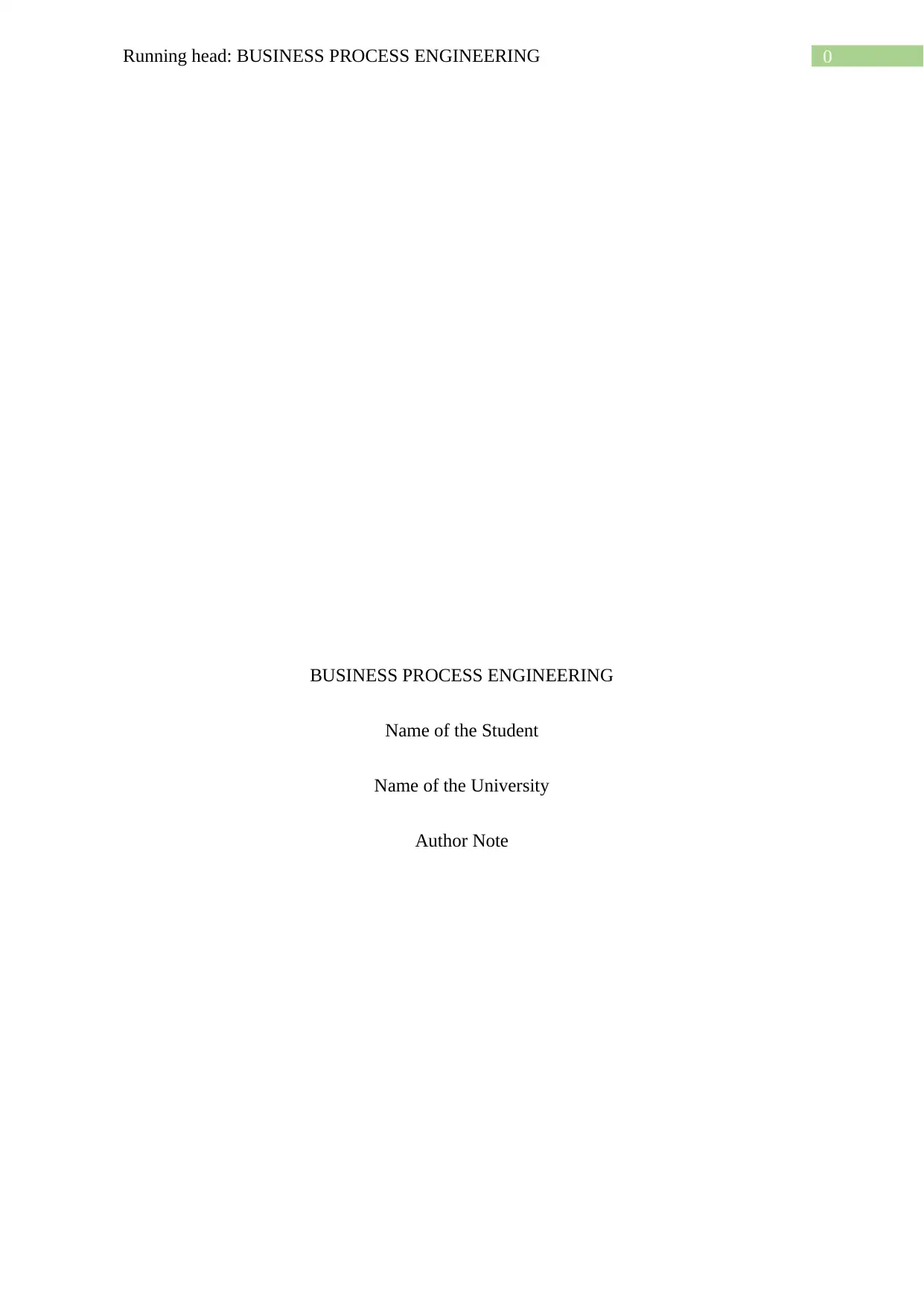
0Running head: BUSINESS PROCESS ENGINEERING
BUSINESS PROCESS ENGINEERING
Name of the Student
Name of the University
Author Note
BUSINESS PROCESS ENGINEERING
Name of the Student
Name of the University
Author Note
Paraphrase This Document
Need a fresh take? Get an instant paraphrase of this document with our AI Paraphraser
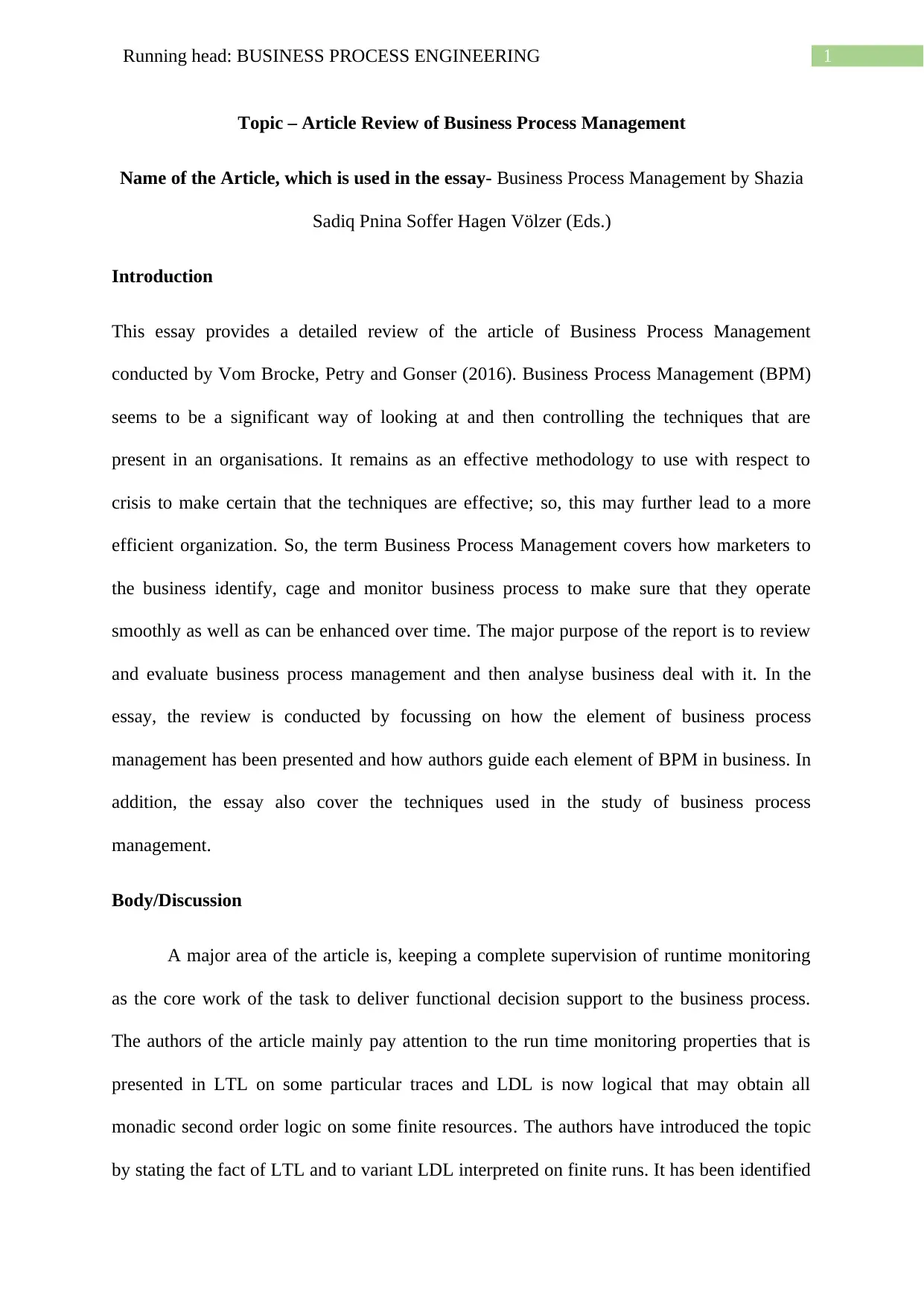
1Running head: BUSINESS PROCESS ENGINEERING
Topic – Article Review of Business Process Management
Name of the Article, which is used in the essay- Business Process Management by Shazia
Sadiq Pnina Soffer Hagen Völzer (Eds.)
Introduction
This essay provides a detailed review of the article of Business Process Management
conducted by Vom Brocke, Petry and Gonser (2016). Business Process Management (BPM)
seems to be a significant way of looking at and then controlling the techniques that are
present in an organisations. It remains as an effective methodology to use with respect to
crisis to make certain that the techniques are effective; so, this may further lead to a more
efficient organization. So, the term Business Process Management covers how marketers to
the business identify, cage and monitor business process to make sure that they operate
smoothly as well as can be enhanced over time. The major purpose of the report is to review
and evaluate business process management and then analyse business deal with it. In the
essay, the review is conducted by focussing on how the element of business process
management has been presented and how authors guide each element of BPM in business. In
addition, the essay also cover the techniques used in the study of business process
management.
Body/Discussion
A major area of the article is, keeping a complete supervision of runtime monitoring
as the core work of the task to deliver functional decision support to the business process.
The authors of the article mainly pay attention to the run time monitoring properties that is
presented in LTL on some particular traces and LDL is now logical that may obtain all
monadic second order logic on some finite resources. The authors have introduced the topic
by stating the fact of LTL and to variant LDL interpreted on finite runs. It has been identified
Topic – Article Review of Business Process Management
Name of the Article, which is used in the essay- Business Process Management by Shazia
Sadiq Pnina Soffer Hagen Völzer (Eds.)
Introduction
This essay provides a detailed review of the article of Business Process Management
conducted by Vom Brocke, Petry and Gonser (2016). Business Process Management (BPM)
seems to be a significant way of looking at and then controlling the techniques that are
present in an organisations. It remains as an effective methodology to use with respect to
crisis to make certain that the techniques are effective; so, this may further lead to a more
efficient organization. So, the term Business Process Management covers how marketers to
the business identify, cage and monitor business process to make sure that they operate
smoothly as well as can be enhanced over time. The major purpose of the report is to review
and evaluate business process management and then analyse business deal with it. In the
essay, the review is conducted by focussing on how the element of business process
management has been presented and how authors guide each element of BPM in business. In
addition, the essay also cover the techniques used in the study of business process
management.
Body/Discussion
A major area of the article is, keeping a complete supervision of runtime monitoring
as the core work of the task to deliver functional decision support to the business process.
The authors of the article mainly pay attention to the run time monitoring properties that is
presented in LTL on some particular traces and LDL is now logical that may obtain all
monadic second order logic on some finite resources. The authors have introduced the topic
by stating the fact of LTL and to variant LDL interpreted on finite runs. It has been identified
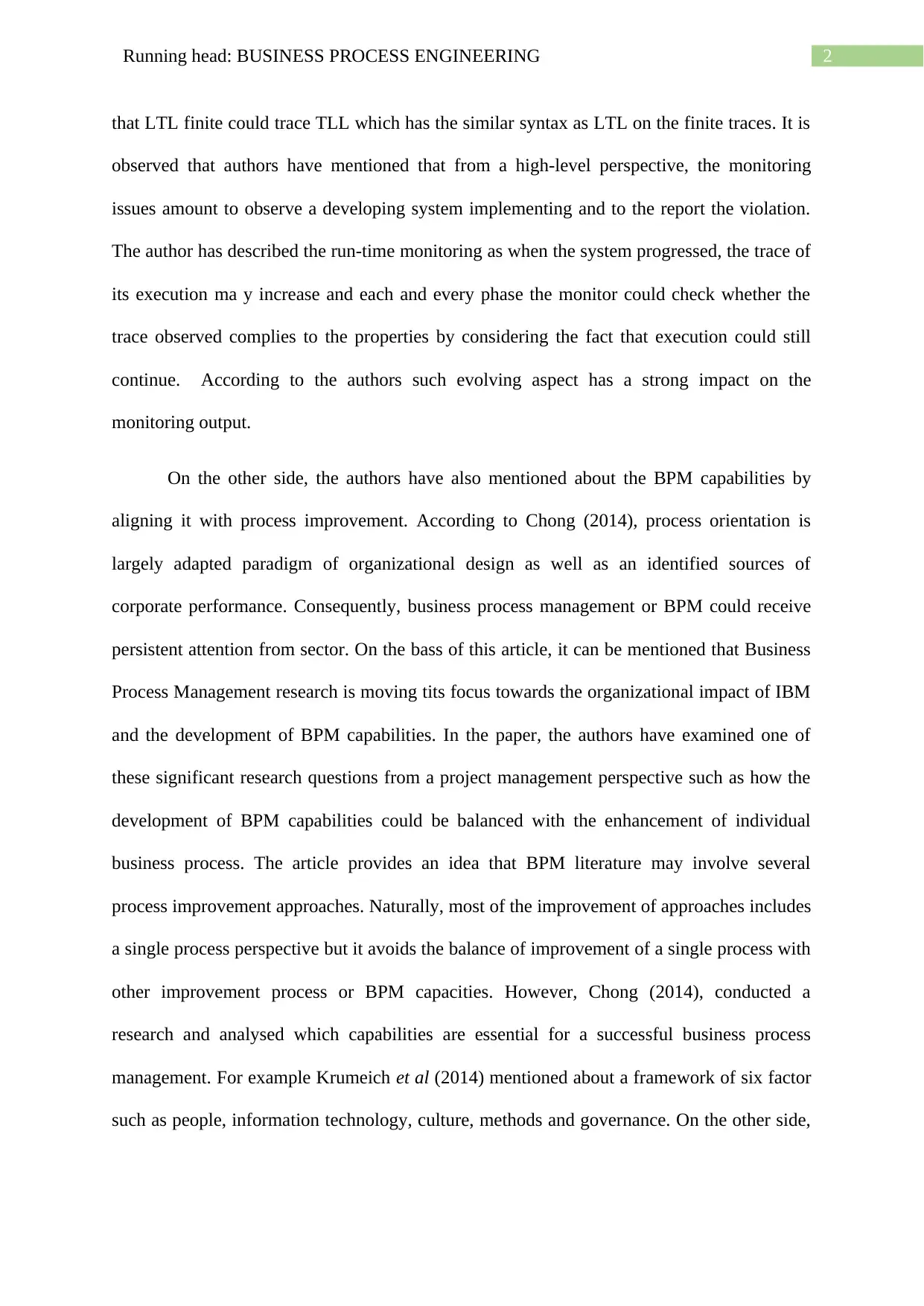
2Running head: BUSINESS PROCESS ENGINEERING
that LTL finite could trace TLL which has the similar syntax as LTL on the finite traces. It is
observed that authors have mentioned that from a high-level perspective, the monitoring
issues amount to observe a developing system implementing and to the report the violation.
The author has described the run-time monitoring as when the system progressed, the trace of
its execution ma y increase and each and every phase the monitor could check whether the
trace observed complies to the properties by considering the fact that execution could still
continue. According to the authors such evolving aspect has a strong impact on the
monitoring output.
On the other side, the authors have also mentioned about the BPM capabilities by
aligning it with process improvement. According to Chong (2014), process orientation is
largely adapted paradigm of organizational design as well as an identified sources of
corporate performance. Consequently, business process management or BPM could receive
persistent attention from sector. On the bass of this article, it can be mentioned that Business
Process Management research is moving tits focus towards the organizational impact of IBM
and the development of BPM capabilities. In the paper, the authors have examined one of
these significant research questions from a project management perspective such as how the
development of BPM capabilities could be balanced with the enhancement of individual
business process. The article provides an idea that BPM literature may involve several
process improvement approaches. Naturally, most of the improvement of approaches includes
a single process perspective but it avoids the balance of improvement of a single process with
other improvement process or BPM capacities. However, Chong (2014), conducted a
research and analysed which capabilities are essential for a successful business process
management. For example Krumeich et al (2014) mentioned about a framework of six factor
such as people, information technology, culture, methods and governance. On the other side,
that LTL finite could trace TLL which has the similar syntax as LTL on the finite traces. It is
observed that authors have mentioned that from a high-level perspective, the monitoring
issues amount to observe a developing system implementing and to the report the violation.
The author has described the run-time monitoring as when the system progressed, the trace of
its execution ma y increase and each and every phase the monitor could check whether the
trace observed complies to the properties by considering the fact that execution could still
continue. According to the authors such evolving aspect has a strong impact on the
monitoring output.
On the other side, the authors have also mentioned about the BPM capabilities by
aligning it with process improvement. According to Chong (2014), process orientation is
largely adapted paradigm of organizational design as well as an identified sources of
corporate performance. Consequently, business process management or BPM could receive
persistent attention from sector. On the bass of this article, it can be mentioned that Business
Process Management research is moving tits focus towards the organizational impact of IBM
and the development of BPM capabilities. In the paper, the authors have examined one of
these significant research questions from a project management perspective such as how the
development of BPM capabilities could be balanced with the enhancement of individual
business process. The article provides an idea that BPM literature may involve several
process improvement approaches. Naturally, most of the improvement of approaches includes
a single process perspective but it avoids the balance of improvement of a single process with
other improvement process or BPM capacities. However, Chong (2014), conducted a
research and analysed which capabilities are essential for a successful business process
management. For example Krumeich et al (2014) mentioned about a framework of six factor
such as people, information technology, culture, methods and governance. On the other side,
⊘ This is a preview!⊘
Do you want full access?
Subscribe today to unlock all pages.

Trusted by 1+ million students worldwide
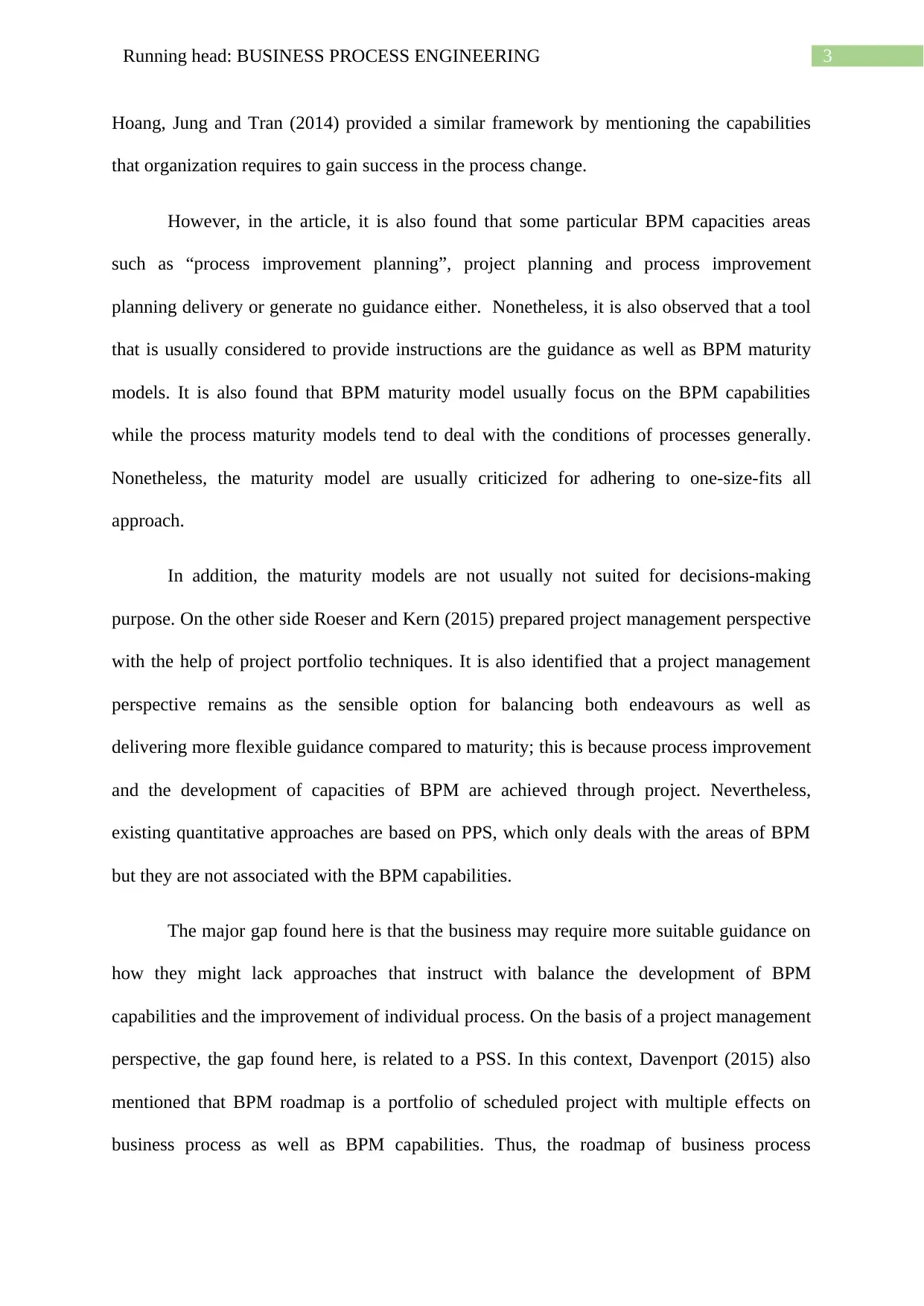
3Running head: BUSINESS PROCESS ENGINEERING
Hoang, Jung and Tran (2014) provided a similar framework by mentioning the capabilities
that organization requires to gain success in the process change.
However, in the article, it is also found that some particular BPM capacities areas
such as “process improvement planning”, project planning and process improvement
planning delivery or generate no guidance either. Nonetheless, it is also observed that a tool
that is usually considered to provide instructions are the guidance as well as BPM maturity
models. It is also found that BPM maturity model usually focus on the BPM capabilities
while the process maturity models tend to deal with the conditions of processes generally.
Nonetheless, the maturity model are usually criticized for adhering to one-size-fits all
approach.
In addition, the maturity models are not usually not suited for decisions-making
purpose. On the other side Roeser and Kern (2015) prepared project management perspective
with the help of project portfolio techniques. It is also identified that a project management
perspective remains as the sensible option for balancing both endeavours as well as
delivering more flexible guidance compared to maturity; this is because process improvement
and the development of capacities of BPM are achieved through project. Nevertheless,
existing quantitative approaches are based on PPS, which only deals with the areas of BPM
but they are not associated with the BPM capabilities.
The major gap found here is that the business may require more suitable guidance on
how they might lack approaches that instruct with balance the development of BPM
capabilities and the improvement of individual process. On the basis of a project management
perspective, the gap found here, is related to a PSS. In this context, Davenport (2015) also
mentioned that BPM roadmap is a portfolio of scheduled project with multiple effects on
business process as well as BPM capabilities. Thus, the roadmap of business process
Hoang, Jung and Tran (2014) provided a similar framework by mentioning the capabilities
that organization requires to gain success in the process change.
However, in the article, it is also found that some particular BPM capacities areas
such as “process improvement planning”, project planning and process improvement
planning delivery or generate no guidance either. Nonetheless, it is also observed that a tool
that is usually considered to provide instructions are the guidance as well as BPM maturity
models. It is also found that BPM maturity model usually focus on the BPM capabilities
while the process maturity models tend to deal with the conditions of processes generally.
Nonetheless, the maturity model are usually criticized for adhering to one-size-fits all
approach.
In addition, the maturity models are not usually not suited for decisions-making
purpose. On the other side Roeser and Kern (2015) prepared project management perspective
with the help of project portfolio techniques. It is also identified that a project management
perspective remains as the sensible option for balancing both endeavours as well as
delivering more flexible guidance compared to maturity; this is because process improvement
and the development of capacities of BPM are achieved through project. Nevertheless,
existing quantitative approaches are based on PPS, which only deals with the areas of BPM
but they are not associated with the BPM capabilities.
The major gap found here is that the business may require more suitable guidance on
how they might lack approaches that instruct with balance the development of BPM
capabilities and the improvement of individual process. On the basis of a project management
perspective, the gap found here, is related to a PSS. In this context, Davenport (2015) also
mentioned that BPM roadmap is a portfolio of scheduled project with multiple effects on
business process as well as BPM capabilities. Thus, the roadmap of business process
Paraphrase This Document
Need a fresh take? Get an instant paraphrase of this document with our AI Paraphraser
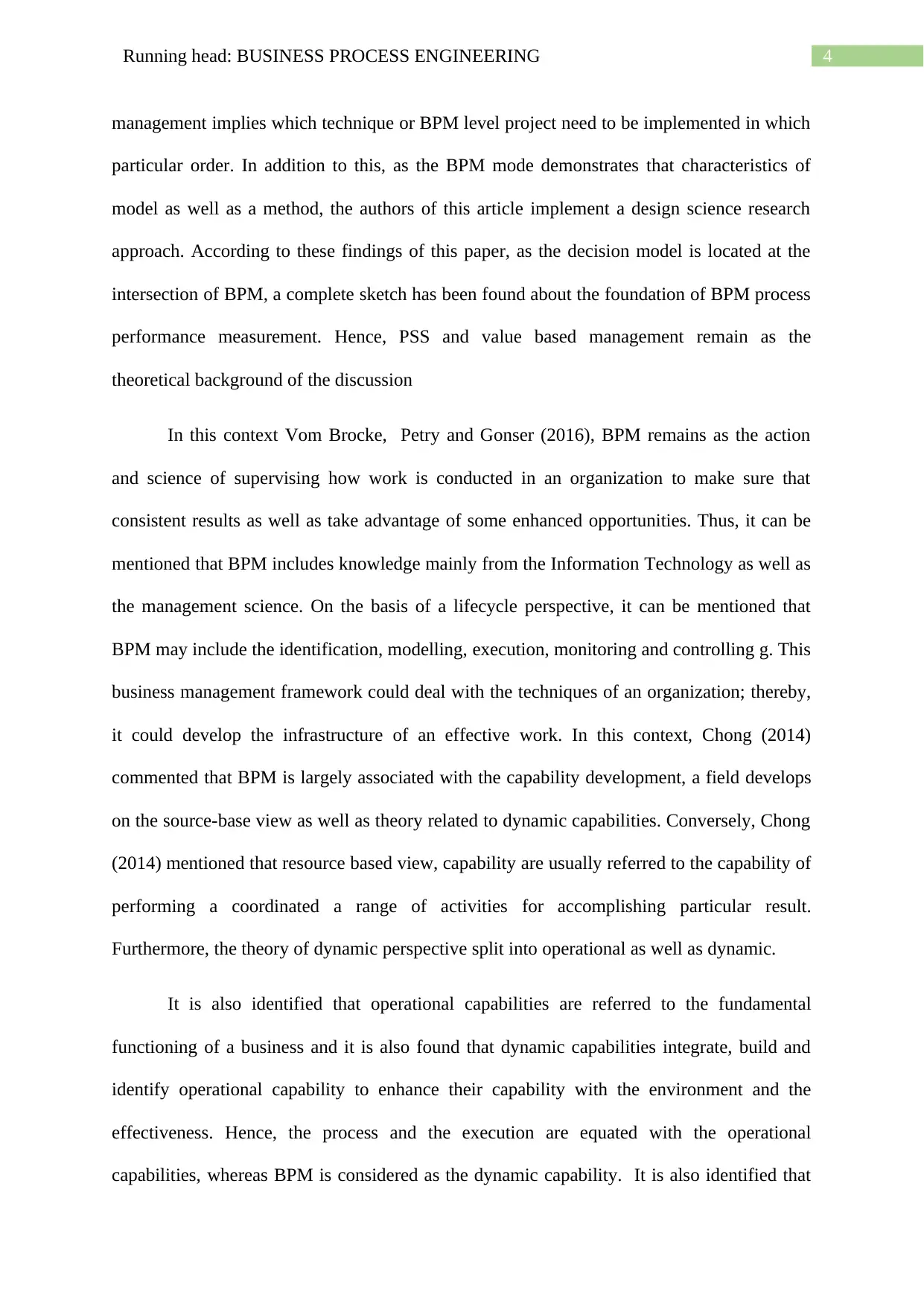
4Running head: BUSINESS PROCESS ENGINEERING
management implies which technique or BPM level project need to be implemented in which
particular order. In addition to this, as the BPM mode demonstrates that characteristics of
model as well as a method, the authors of this article implement a design science research
approach. According to these findings of this paper, as the decision model is located at the
intersection of BPM, a complete sketch has been found about the foundation of BPM process
performance measurement. Hence, PSS and value based management remain as the
theoretical background of the discussion
In this context Vom Brocke, Petry and Gonser (2016), BPM remains as the action
and science of supervising how work is conducted in an organization to make sure that
consistent results as well as take advantage of some enhanced opportunities. Thus, it can be
mentioned that BPM includes knowledge mainly from the Information Technology as well as
the management science. On the basis of a lifecycle perspective, it can be mentioned that
BPM may include the identification, modelling, execution, monitoring and controlling g. This
business management framework could deal with the techniques of an organization; thereby,
it could develop the infrastructure of an effective work. In this context, Chong (2014)
commented that BPM is largely associated with the capability development, a field develops
on the source-base view as well as theory related to dynamic capabilities. Conversely, Chong
(2014) mentioned that resource based view, capability are usually referred to the capability of
performing a coordinated a range of activities for accomplishing particular result.
Furthermore, the theory of dynamic perspective split into operational as well as dynamic.
It is also identified that operational capabilities are referred to the fundamental
functioning of a business and it is also found that dynamic capabilities integrate, build and
identify operational capability to enhance their capability with the environment and the
effectiveness. Hence, the process and the execution are equated with the operational
capabilities, whereas BPM is considered as the dynamic capability. It is also identified that
management implies which technique or BPM level project need to be implemented in which
particular order. In addition to this, as the BPM mode demonstrates that characteristics of
model as well as a method, the authors of this article implement a design science research
approach. According to these findings of this paper, as the decision model is located at the
intersection of BPM, a complete sketch has been found about the foundation of BPM process
performance measurement. Hence, PSS and value based management remain as the
theoretical background of the discussion
In this context Vom Brocke, Petry and Gonser (2016), BPM remains as the action
and science of supervising how work is conducted in an organization to make sure that
consistent results as well as take advantage of some enhanced opportunities. Thus, it can be
mentioned that BPM includes knowledge mainly from the Information Technology as well as
the management science. On the basis of a lifecycle perspective, it can be mentioned that
BPM may include the identification, modelling, execution, monitoring and controlling g. This
business management framework could deal with the techniques of an organization; thereby,
it could develop the infrastructure of an effective work. In this context, Chong (2014)
commented that BPM is largely associated with the capability development, a field develops
on the source-base view as well as theory related to dynamic capabilities. Conversely, Chong
(2014) mentioned that resource based view, capability are usually referred to the capability of
performing a coordinated a range of activities for accomplishing particular result.
Furthermore, the theory of dynamic perspective split into operational as well as dynamic.
It is also identified that operational capabilities are referred to the fundamental
functioning of a business and it is also found that dynamic capabilities integrate, build and
identify operational capability to enhance their capability with the environment and the
effectiveness. Hence, the process and the execution are equated with the operational
capabilities, whereas BPM is considered as the dynamic capability. It is also identified that
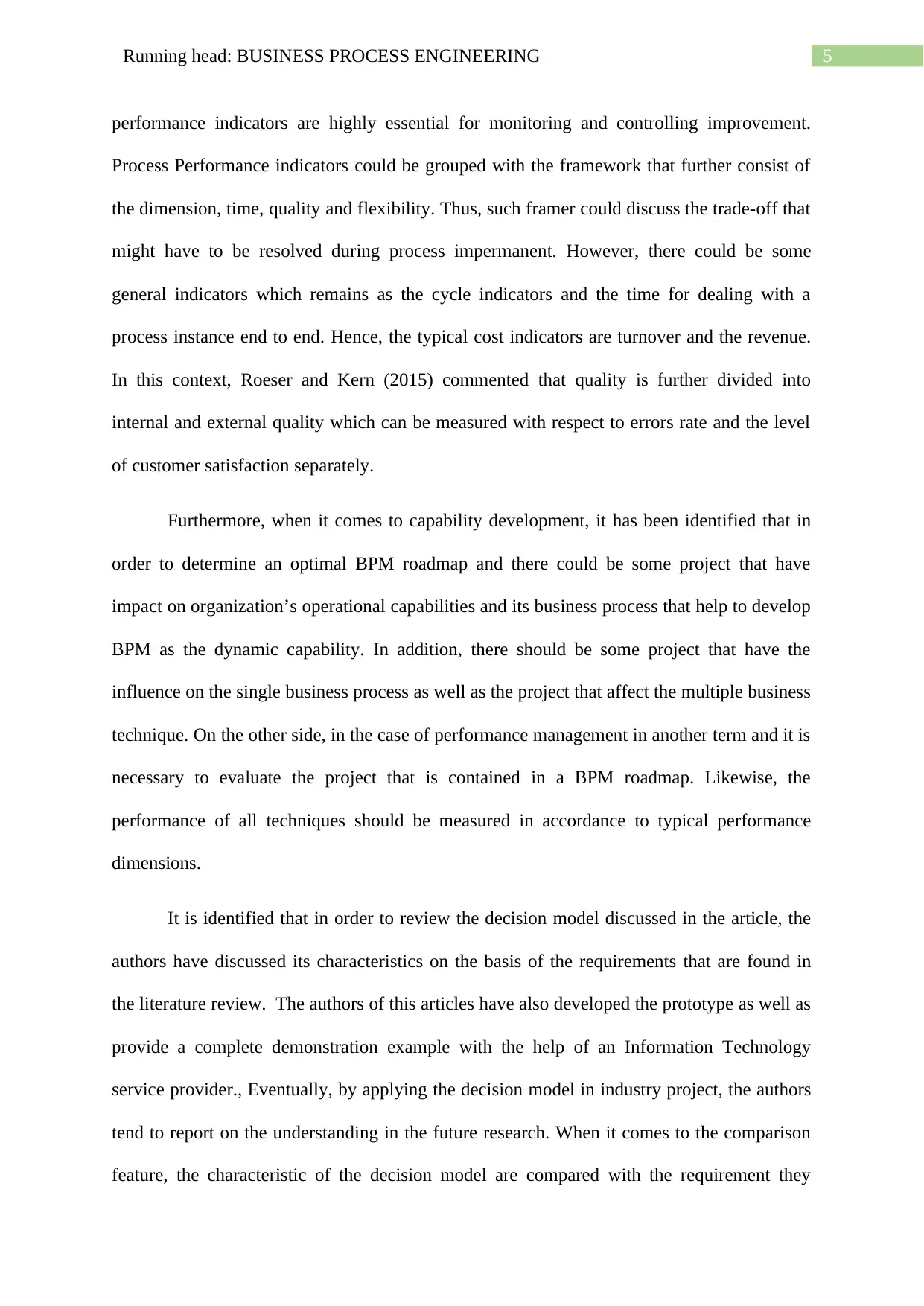
5Running head: BUSINESS PROCESS ENGINEERING
performance indicators are highly essential for monitoring and controlling improvement.
Process Performance indicators could be grouped with the framework that further consist of
the dimension, time, quality and flexibility. Thus, such framer could discuss the trade-off that
might have to be resolved during process impermanent. However, there could be some
general indicators which remains as the cycle indicators and the time for dealing with a
process instance end to end. Hence, the typical cost indicators are turnover and the revenue.
In this context, Roeser and Kern (2015) commented that quality is further divided into
internal and external quality which can be measured with respect to errors rate and the level
of customer satisfaction separately.
Furthermore, when it comes to capability development, it has been identified that in
order to determine an optimal BPM roadmap and there could be some project that have
impact on organization’s operational capabilities and its business process that help to develop
BPM as the dynamic capability. In addition, there should be some project that have the
influence on the single business process as well as the project that affect the multiple business
technique. On the other side, in the case of performance management in another term and it is
necessary to evaluate the project that is contained in a BPM roadmap. Likewise, the
performance of all techniques should be measured in accordance to typical performance
dimensions.
It is identified that in order to review the decision model discussed in the article, the
authors have discussed its characteristics on the basis of the requirements that are found in
the literature review. The authors of this articles have also developed the prototype as well as
provide a complete demonstration example with the help of an Information Technology
service provider., Eventually, by applying the decision model in industry project, the authors
tend to report on the understanding in the future research. When it comes to the comparison
feature, the characteristic of the decision model are compared with the requirement they
performance indicators are highly essential for monitoring and controlling improvement.
Process Performance indicators could be grouped with the framework that further consist of
the dimension, time, quality and flexibility. Thus, such framer could discuss the trade-off that
might have to be resolved during process impermanent. However, there could be some
general indicators which remains as the cycle indicators and the time for dealing with a
process instance end to end. Hence, the typical cost indicators are turnover and the revenue.
In this context, Roeser and Kern (2015) commented that quality is further divided into
internal and external quality which can be measured with respect to errors rate and the level
of customer satisfaction separately.
Furthermore, when it comes to capability development, it has been identified that in
order to determine an optimal BPM roadmap and there could be some project that have
impact on organization’s operational capabilities and its business process that help to develop
BPM as the dynamic capability. In addition, there should be some project that have the
influence on the single business process as well as the project that affect the multiple business
technique. On the other side, in the case of performance management in another term and it is
necessary to evaluate the project that is contained in a BPM roadmap. Likewise, the
performance of all techniques should be measured in accordance to typical performance
dimensions.
It is identified that in order to review the decision model discussed in the article, the
authors have discussed its characteristics on the basis of the requirements that are found in
the literature review. The authors of this articles have also developed the prototype as well as
provide a complete demonstration example with the help of an Information Technology
service provider., Eventually, by applying the decision model in industry project, the authors
tend to report on the understanding in the future research. When it comes to the comparison
feature, the characteristic of the decision model are compared with the requirement they
⊘ This is a preview!⊘
Do you want full access?
Subscribe today to unlock all pages.

Trusted by 1+ million students worldwide
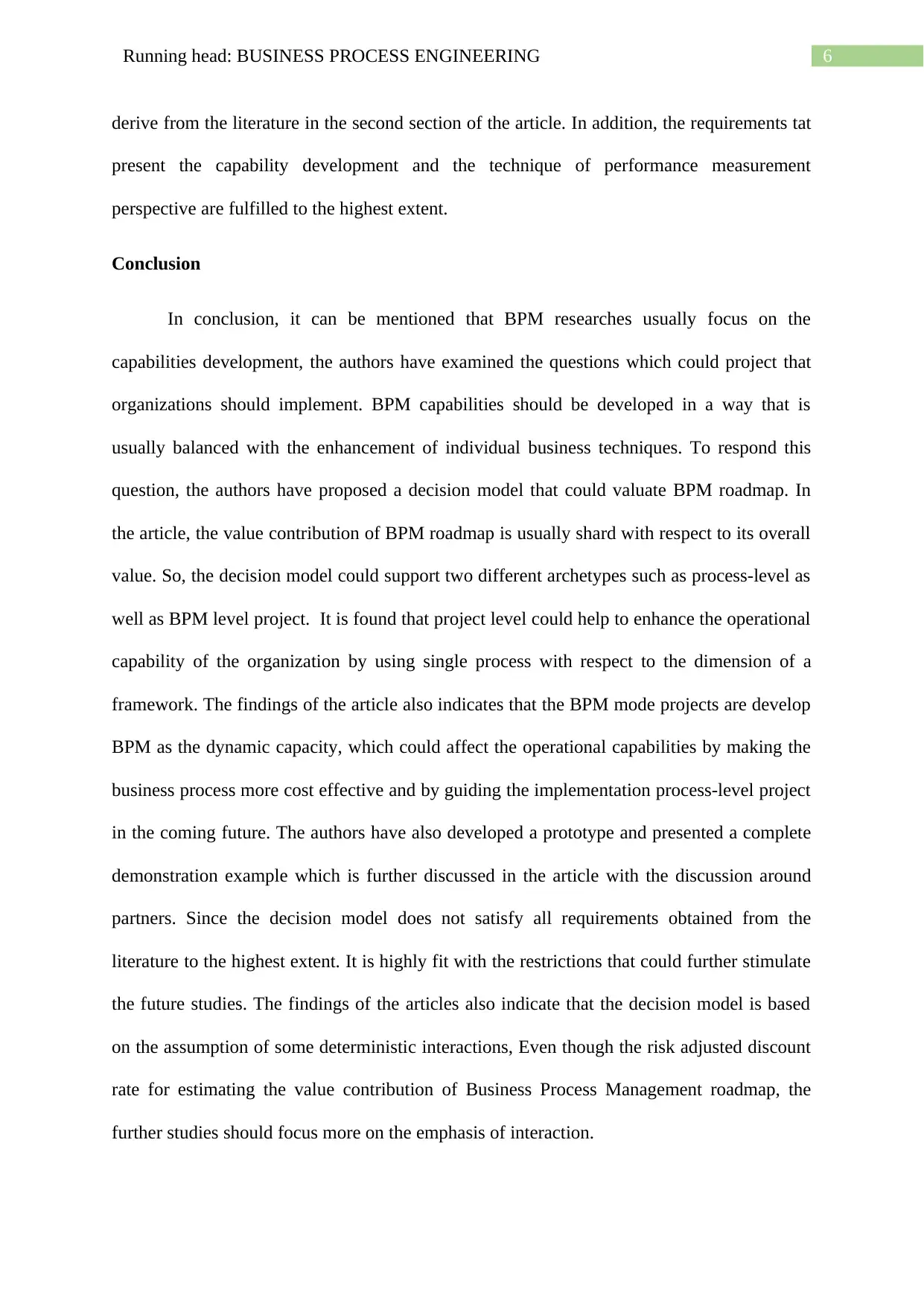
6Running head: BUSINESS PROCESS ENGINEERING
derive from the literature in the second section of the article. In addition, the requirements tat
present the capability development and the technique of performance measurement
perspective are fulfilled to the highest extent.
Conclusion
In conclusion, it can be mentioned that BPM researches usually focus on the
capabilities development, the authors have examined the questions which could project that
organizations should implement. BPM capabilities should be developed in a way that is
usually balanced with the enhancement of individual business techniques. To respond this
question, the authors have proposed a decision model that could valuate BPM roadmap. In
the article, the value contribution of BPM roadmap is usually shard with respect to its overall
value. So, the decision model could support two different archetypes such as process-level as
well as BPM level project. It is found that project level could help to enhance the operational
capability of the organization by using single process with respect to the dimension of a
framework. The findings of the article also indicates that the BPM mode projects are develop
BPM as the dynamic capacity, which could affect the operational capabilities by making the
business process more cost effective and by guiding the implementation process-level project
in the coming future. The authors have also developed a prototype and presented a complete
demonstration example which is further discussed in the article with the discussion around
partners. Since the decision model does not satisfy all requirements obtained from the
literature to the highest extent. It is highly fit with the restrictions that could further stimulate
the future studies. The findings of the articles also indicate that the decision model is based
on the assumption of some deterministic interactions, Even though the risk adjusted discount
rate for estimating the value contribution of Business Process Management roadmap, the
further studies should focus more on the emphasis of interaction.
derive from the literature in the second section of the article. In addition, the requirements tat
present the capability development and the technique of performance measurement
perspective are fulfilled to the highest extent.
Conclusion
In conclusion, it can be mentioned that BPM researches usually focus on the
capabilities development, the authors have examined the questions which could project that
organizations should implement. BPM capabilities should be developed in a way that is
usually balanced with the enhancement of individual business techniques. To respond this
question, the authors have proposed a decision model that could valuate BPM roadmap. In
the article, the value contribution of BPM roadmap is usually shard with respect to its overall
value. So, the decision model could support two different archetypes such as process-level as
well as BPM level project. It is found that project level could help to enhance the operational
capability of the organization by using single process with respect to the dimension of a
framework. The findings of the article also indicates that the BPM mode projects are develop
BPM as the dynamic capacity, which could affect the operational capabilities by making the
business process more cost effective and by guiding the implementation process-level project
in the coming future. The authors have also developed a prototype and presented a complete
demonstration example which is further discussed in the article with the discussion around
partners. Since the decision model does not satisfy all requirements obtained from the
literature to the highest extent. It is highly fit with the restrictions that could further stimulate
the future studies. The findings of the articles also indicate that the decision model is based
on the assumption of some deterministic interactions, Even though the risk adjusted discount
rate for estimating the value contribution of Business Process Management roadmap, the
further studies should focus more on the emphasis of interaction.
Paraphrase This Document
Need a fresh take? Get an instant paraphrase of this document with our AI Paraphraser

7Running head: BUSINESS PROCESS ENGINEERING
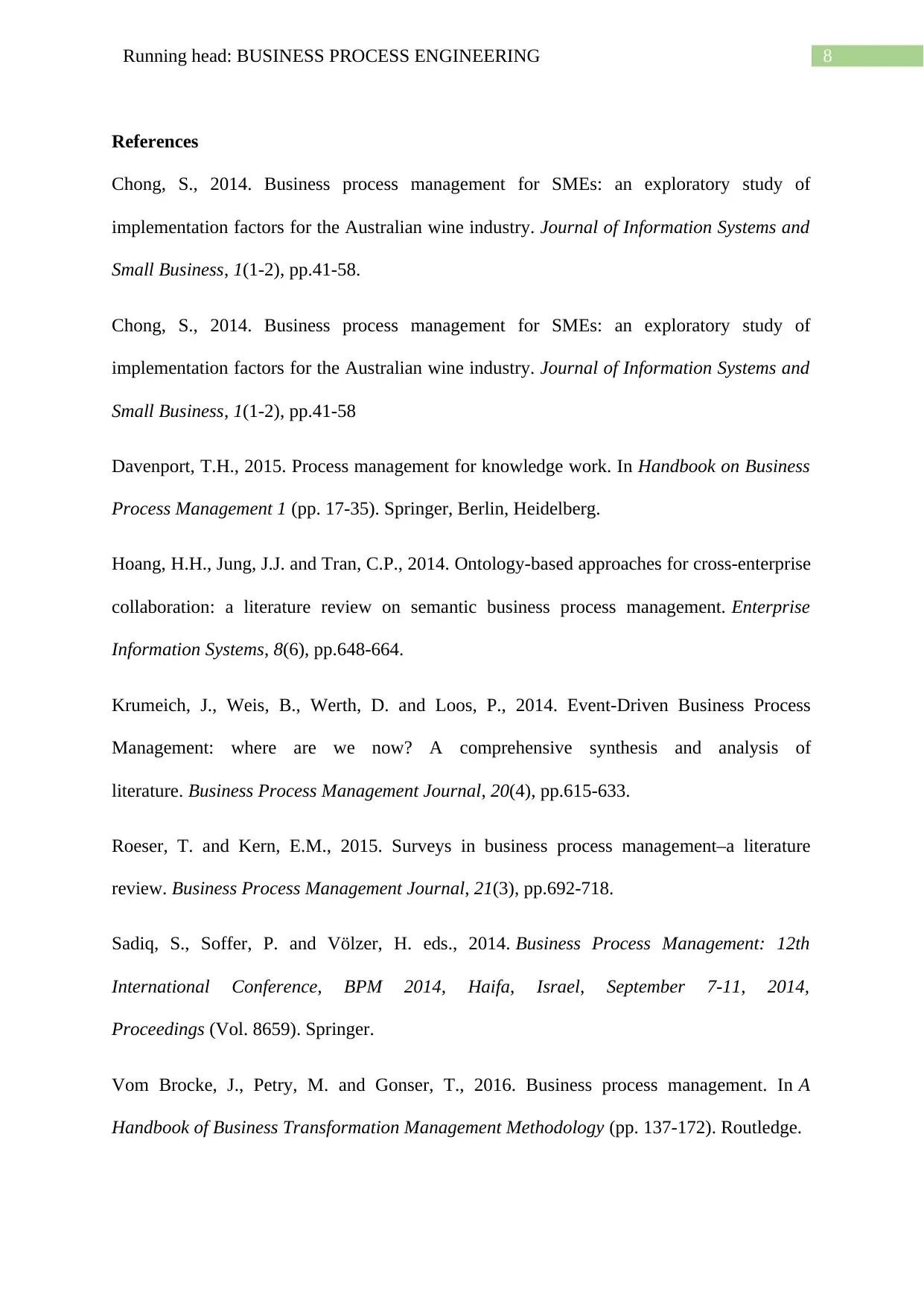
8Running head: BUSINESS PROCESS ENGINEERING
References
Chong, S., 2014. Business process management for SMEs: an exploratory study of
implementation factors for the Australian wine industry. Journal of Information Systems and
Small Business, 1(1-2), pp.41-58.
Chong, S., 2014. Business process management for SMEs: an exploratory study of
implementation factors for the Australian wine industry. Journal of Information Systems and
Small Business, 1(1-2), pp.41-58
Davenport, T.H., 2015. Process management for knowledge work. In Handbook on Business
Process Management 1 (pp. 17-35). Springer, Berlin, Heidelberg.
Hoang, H.H., Jung, J.J. and Tran, C.P., 2014. Ontology-based approaches for cross-enterprise
collaboration: a literature review on semantic business process management. Enterprise
Information Systems, 8(6), pp.648-664.
Krumeich, J., Weis, B., Werth, D. and Loos, P., 2014. Event-Driven Business Process
Management: where are we now? A comprehensive synthesis and analysis of
literature. Business Process Management Journal, 20(4), pp.615-633.
Roeser, T. and Kern, E.M., 2015. Surveys in business process management–a literature
review. Business Process Management Journal, 21(3), pp.692-718.
Sadiq, S., Soffer, P. and Völzer, H. eds., 2014. Business Process Management: 12th
International Conference, BPM 2014, Haifa, Israel, September 7-11, 2014,
Proceedings (Vol. 8659). Springer.
Vom Brocke, J., Petry, M. and Gonser, T., 2016. Business process management. In A
Handbook of Business Transformation Management Methodology (pp. 137-172). Routledge.
References
Chong, S., 2014. Business process management for SMEs: an exploratory study of
implementation factors for the Australian wine industry. Journal of Information Systems and
Small Business, 1(1-2), pp.41-58.
Chong, S., 2014. Business process management for SMEs: an exploratory study of
implementation factors for the Australian wine industry. Journal of Information Systems and
Small Business, 1(1-2), pp.41-58
Davenport, T.H., 2015. Process management for knowledge work. In Handbook on Business
Process Management 1 (pp. 17-35). Springer, Berlin, Heidelberg.
Hoang, H.H., Jung, J.J. and Tran, C.P., 2014. Ontology-based approaches for cross-enterprise
collaboration: a literature review on semantic business process management. Enterprise
Information Systems, 8(6), pp.648-664.
Krumeich, J., Weis, B., Werth, D. and Loos, P., 2014. Event-Driven Business Process
Management: where are we now? A comprehensive synthesis and analysis of
literature. Business Process Management Journal, 20(4), pp.615-633.
Roeser, T. and Kern, E.M., 2015. Surveys in business process management–a literature
review. Business Process Management Journal, 21(3), pp.692-718.
Sadiq, S., Soffer, P. and Völzer, H. eds., 2014. Business Process Management: 12th
International Conference, BPM 2014, Haifa, Israel, September 7-11, 2014,
Proceedings (Vol. 8659). Springer.
Vom Brocke, J., Petry, M. and Gonser, T., 2016. Business process management. In A
Handbook of Business Transformation Management Methodology (pp. 137-172). Routledge.
⊘ This is a preview!⊘
Do you want full access?
Subscribe today to unlock all pages.

Trusted by 1+ million students worldwide

9Running head: BUSINESS PROCESS ENGINEERING
1 out of 10
Related Documents
Your All-in-One AI-Powered Toolkit for Academic Success.
+13062052269
info@desklib.com
Available 24*7 on WhatsApp / Email
![[object Object]](/_next/static/media/star-bottom.7253800d.svg)
Unlock your academic potential
Copyright © 2020–2025 A2Z Services. All Rights Reserved. Developed and managed by ZUCOL.





